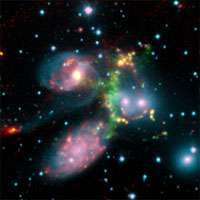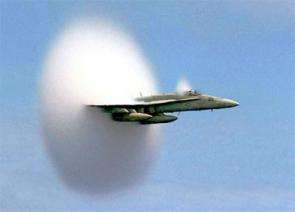Gigantic cosmic cataclysm in Stephan's Quintet of galaxies

Recent infrared observations made with NASA's Spitzer Space Telescope have revealed the presence of a huge intergalactic shock wave, or "sonic boom" in the middle of Stephan's Quintet, a group of galaxies which is now the scene of a gigantic cosmic cataclysm. This discovery, made by an international research team including scientists from the Max Planck Institute for Nuclear Physics (MPIK) in Heidelberg, provides a local view of what might have been going on in the early universe, when vast mergers and collisions between galaxies were commonplace.
When astronomers using NASA's Spitzer Space Telescope turned their attention to a well-known group of galaxies called Stephan's Quintet, they were, quite simply, shocked at what they saw. There, sweeping through the group, lurks one of the biggest shock waves ever seen.
For decades, astronomers using optical telescopes have known that the galaxies in this group, located about 300 million light years away, have a very distorted distribution of visible light from stars, indicating that the galaxies have experienced encounters in the past, and are now engaged in further collisions. But this, as it turns out, is only part of the drama. Recently, astronomers have become able to measure what, apart from the stars, is present in Stephan's Quintet. By looking in the radio and X-rays they discovered huge quantities of gas - about 100,000 million solar masses, mainly composed of hydrogen and helium - in the space between the galaxies, more than all the gas inside the galaxies themselves.

Now, a team of scientists from Caltech, USA and from the Astrophysics Department of the Max Planck Institute for Nuclear Physics (MPIK) in Heidelberg, Germany, together with other collaborators from the USA and Australia, have turned the Spitzer Space Telescope, equipped with a super-sensitive infrared spectrograph, towards the location of the group. They discovered that one of the galaxies, called NGC7318b, which is falling towards the others at high speed, is generating a giant shock wave in front of it - larger even than the Milky Way - as it ploughs its way through the intergalactic gas. The results of this amazing discovery are to be published on March 10th in a paper in the Astrophysical Journal Letters.
The signature of the shock-wave was given by the detection of strong radiation from molecular hydrogen. When hydrogen molecules are "excited" by the mechanical energy produced in the collision and transported by shock waves, they emit a distinctive type of radiation that can be detected in the infrared, and it was this radiation that was picked up by Spitzer. "The strength of the emission and the fact that it shows the gas to be highly disturbed was a huge surprise to us, said team leader Dr. Phil Appleton. "We expected to see the spectral signature of dust grains - but instead we saw an almost pure laboratory-like spectrum of hydrogen molecules and almost nothing else. It was quite unlike anything we had seen before in a galaxy system."
Spectrometers have the ability to break light down into its component wavelengths, where the chemical signatures of the material that produced it can be seen as spectral lines. The width of these lines allows astronomers to determine the velocity of the gas, with wider lines indicating gas at a higher velocity. The hydrogen line seen by Spitzer in Stephan's Quintet is the widest ever observed for hot hydrogen molecules, corresponding to gas motions of 870 kilometres per second, equivalent to a Mach number of 100 or more. "To better understand this situation", says Dr. Richard Tuffs, a team member from MPIK, "one can think of the shock waves created by supersonic aircraft in the Earth atmosphere. There, water droplets can condense behind the shock in humid conditions, while in Stephan's Quintet hydrogen molecules could form out of a turbulent and cooling intergalactic medium. Of course, all this is happening on an enormous scale in Stephan's Quintet."
The Spitzer observations provide a new diagnostic for studying conditions in merging and colliding galaxies, which were much more prevalent in the early universe. "Observing a nearby densely populated galaxy group, immersed in a thick gas cloud, gives us a local view of what might have been going on in the early universe about 10 billion years ago, soon after the first galaxies formed, when the intergalactic medium
and the galaxy density were much greater than today. In this respect these observations are a bit like stepping into a time machine", said Dr. Cristina Popescu, another team member from MPIK. The new results may indicate that some of the emission from the most luminous infrared galaxies seen in the very distant Universe may actually be created not by stars, but by vast shocks in the gas between the colliding galaxies.
Though far in the future, it is likely that in about two billion years from now, we will collide with the slightly larger neighbouring Andromeda Galaxy, creating shocks of our own.
Original work: P.N. Appleton, K.C. Xu , W. Reach , M.A. Dopita , Y. Gao , N. Lu , C.C. Popescu, J.W. Sulentic, R.J. Tuffs, and M.S. Yun, Powerful High-Velocity Dispersion Molecular Hydrogen Associated with an Intergalactic Shock Wave in Stephan's Quintet, The Astrophysical Journal, 639:L51-L54, 10 March 2006
Source: Max-Planck-Gesellschaft















